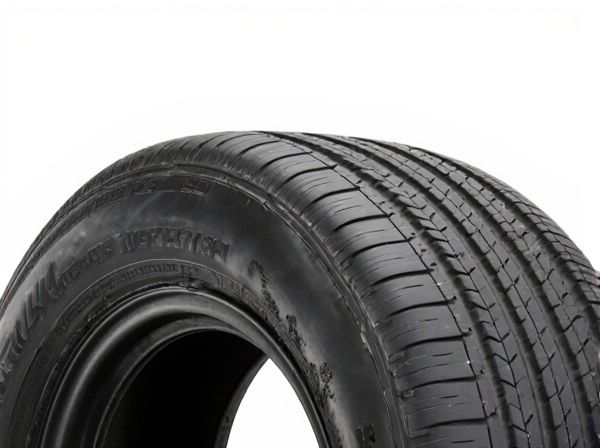
Photo illustration: Reinforced Sidewall vs Standard Sidewall
Reinforced sidewalls offer enhanced durability and resistance to punctures, making them ideal for heavy-duty or off-road driving conditions. Standard sidewalls provide a smoother ride and improved fuel efficiency, better suited for everyday city and highway use. Choosing the right option depends on your driving style and the terrain you frequently encounter.
Table of Comparison
| Feature | Reinforced Sidewall Tires | Standard Sidewall Tires |
|---|---|---|
| Durability | Higher resistance to cuts and impacts | Moderate resistance to damage |
| Load Capacity | Supports heavier loads | Suitable for standard load |
| Ride Comfort | Stiffer sidewall, less cushion | Softer sidewall, smoother ride |
| Cost | Generally more expensive | Lower cost |
| Use Case | Off-road, heavy vehicles, rough terrain | Everyday driving, passenger cars |
Introduction to Tire Sidewall Types
Reinforced sidewalls feature extra layers of strong materials such as Kevlar or steel belts, providing enhanced durability and resistance against punctures compared to standard sidewalls. Standard sidewalls are typically lighter and more flexible, designed for regular road use, offering a smoother and quieter ride but with less protection against impacts and rough terrain. Choosing between reinforced and standard sidewalls depends on driving conditions, vehicle load, and the need for added sidewall strength or comfort.
What Are Reinforced Sidewalls?
Reinforced sidewalls are tire components designed with extra layers of rubber and fabric to enhance durability and resistance to impacts, punctures, and abrasions. These sidewalls provide improved protection against rough terrains, making them ideal for off-road vehicles, trucks, and heavy-duty applications. Compared to standard sidewalls, reinforced versions significantly reduce the risk of sidewall damage, extending tire lifespan and ensuring safer performance under demanding conditions.
Understanding Standard Sidewalls
Standard sidewalls provide basic protection for tire edges, offering a balance between flexibility and durability suitable for everyday driving conditions. They are designed with thinner rubber layers compared to reinforced sidewalls, which helps in maintaining a smoother ride and better fuel efficiency. However, standard sidewalls are more susceptible to punctures and damage when exposed to rough terrain or heavy loads, limiting their use to regular road surfaces.
Key Differences Between Reinforced and Standard Sidewalls
Reinforced sidewalls feature extra layers of rubber and fabric designed to enhance tire durability, resistance to punctures, and overall strength, making them ideal for rugged terrains and heavy loads. Standard sidewalls typically use fewer layers, providing a smoother ride and better flexibility but with less protection against impacts and wear. These differences impact tire longevity, performance, and suitability for various driving conditions, with reinforced sidewalls offering superior robustness at the cost of a slightly firmer ride.
Performance Benefits of Reinforced Sidewalls
Reinforced sidewalls provide enhanced durability and improved resistance to punctures and cuts compared to standard sidewalls, making them ideal for rugged terrain and heavy loads. This increased toughness allows for better tire stability and longevity, reducing downtime and replacement frequency. Performance benefits include superior handling and traction under challenging conditions, boosting overall vehicle safety and efficiency.
Situations Ideal for Standard Sidewalls
Standard sidewalls offer a lightweight design that enhances fuel efficiency and provides a smoother ride on paved roads and well-maintained surfaces. Ideal for everyday commuting and city driving, standard sidewalls deliver sufficient durability without the added weight of reinforced layers. These sidewalls perform best in environments with minimal debris and low risk of punctures, where maximum comfort and fuel economy are prioritized.
Impact on Vehicle Handling and Safety
Reinforced sidewalls enhance vehicle handling by providing increased tire stability and resistance to deformation during sharp turns and rough terrain, resulting in improved grip and control. This added strength reduces the risk of sidewall punctures and blowouts, significantly boosting overall safety, especially in off-road or heavy-load conditions. Standard sidewalls offer more flexibility but can compromise stability and protection, potentially affecting both vehicle performance and occupant safety.
Durability and Longevity Comparison
Reinforced sidewalls provide enhanced durability by incorporating extra layers of rubber and fabric, making them resistant to punctures and impacts compared to standard sidewalls. This construction significantly extends tire longevity, especially under harsh driving conditions or heavy loads. Vehicles equipped with reinforced sidewalls experience fewer sidewall damages, resulting in longer tire lifespan and reduced maintenance costs.
Cost Considerations: Reinforced vs Standard Sidewalls
Reinforced sidewalls typically incur higher upfront costs compared to standard sidewalls due to the use of stronger materials and enhanced construction techniques. Despite the increased initial investment, reinforced sidewalls offer greater durability and resistance to punctures, potentially reducing long-term maintenance and replacement expenses. For businesses prioritizing cost-efficiency over time, evaluating the total cost of ownership including downtime and repair savings is crucial when choosing between reinforced and standard sidewalls.
How to Choose the Right Sidewall for Your Vehicle
Choosing the right sidewall for your vehicle depends on your driving needs and road conditions. Reinforced sidewalls offer enhanced durability and protection against punctures, ideal for off-road or heavy-duty use, while standard sidewalls provide a smoother ride and better fuel efficiency suited for everyday commuting on paved roads. Assessing factors such as load capacity, terrain type, and expected tire wear helps determine whether reinforced or standard sidewalls best meet your vehicle's performance and safety requirements.
 caratoz.com
caratoz.com